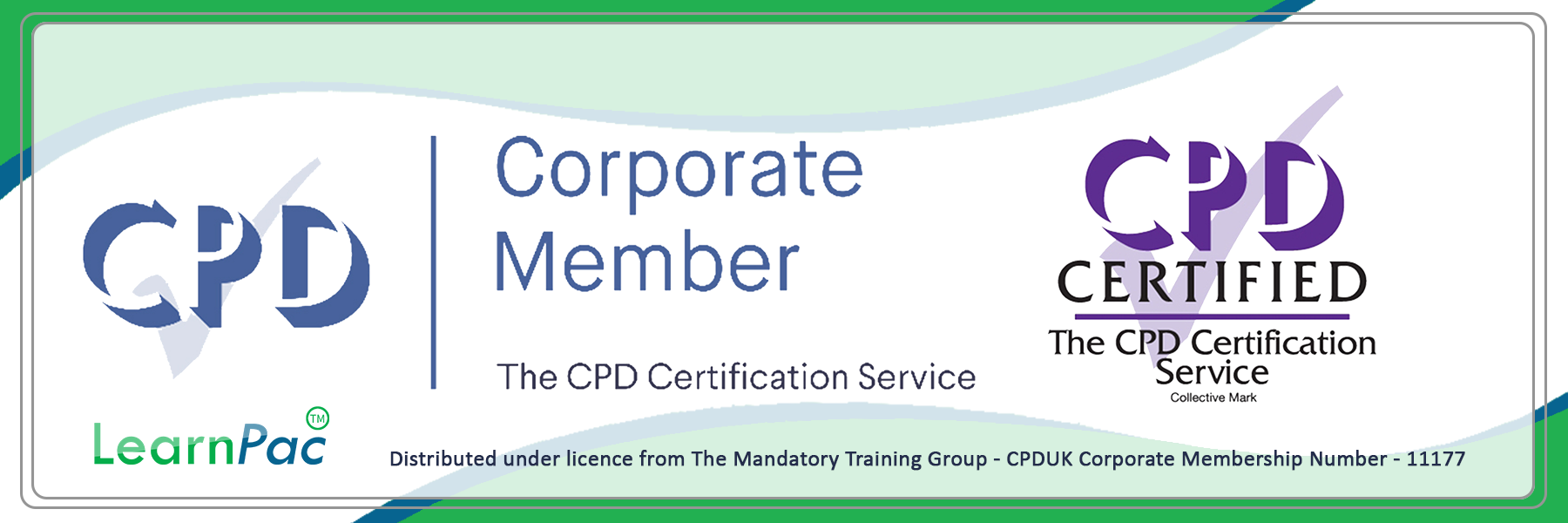Cardiopulmonary Resuscitation - E-Learning Courses - CPDUK Accredited
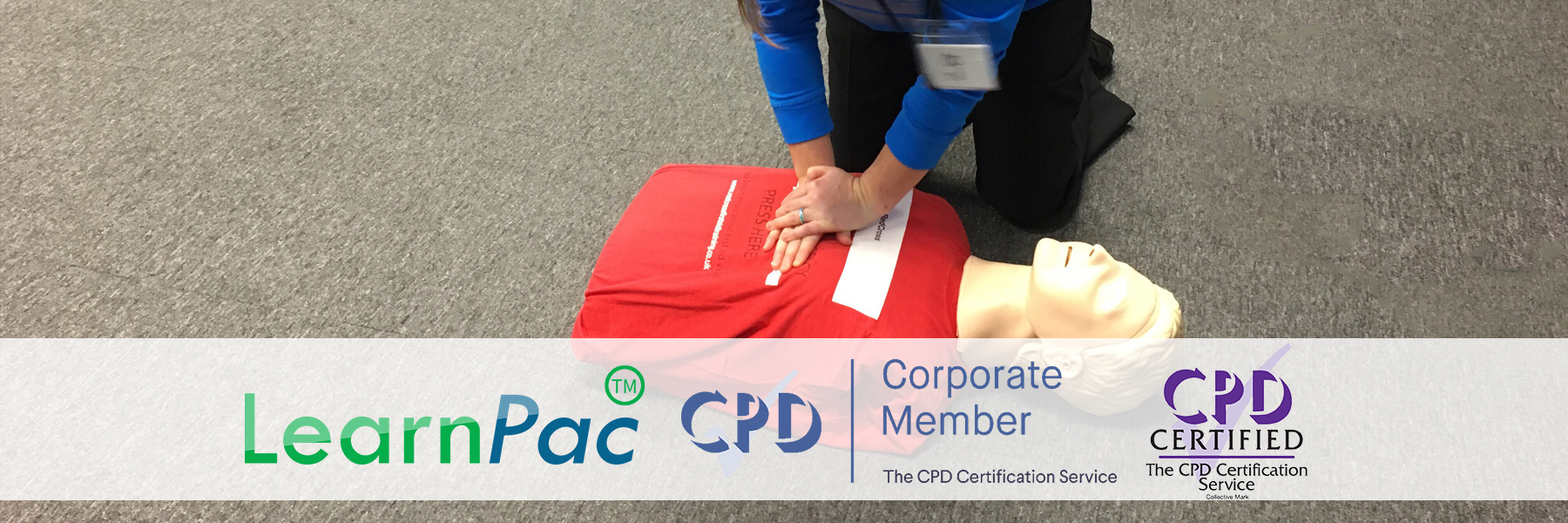
Cardiopulmonary Resuscitation – E-Learning Courses with Certificates – CPDUK Accredited.
LearnPac Systems is the leading UK provider of accredited statutory and mandatory training courses for all sectors, including health and social care, education, local government, private and charity sectors.
Cardiopulmonary resuscitation (CPR) is performed on people who do not have a pulse and have stopped breathing. CPR aims to compress the chest and heart so that blood can be pumped to the brain.
Our cardiopulmonary resuscitation courses will provide learners with the necessary steps to administer efficient CPR (Cardiopulmonary Resuscitation) in a variety of environments. This course will also extend adequate support on how to set up and use an AED (Automated External Defibrillator) correctly.
Browse our Cardiopulmonary Resuscitation - E-Learning Courses
-
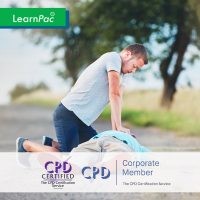
CSTF Resuscitation – Adult Basic Life Support – Level 1 – CPD Accredited
£ 14.99 excl. VAT Buy now -
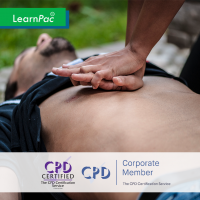
CSTF Resuscitation (Adult Basic Life Support) – Level 2
£ 19.99 excl. VAT Buy now -
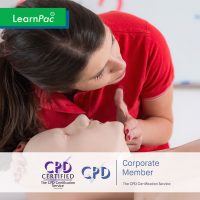
First Aid, CPR and AED Awareness – Online Training Course – CPDUK Accredited
£ 39.99 excl. VAT Buy now -
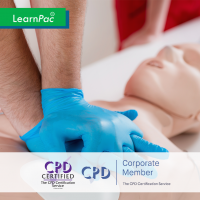
Resuscitation Immediate Life Support – Level 3 – CPDUK Accredited
£ 24.99 excl. VAT Buy now
Cardiopulmonary Resuscitation: Frequently Asked Questions and Answers
Cardiopulmonary Resuscitation – E-Learning Courses with Certificates – CPDUK Accredited – LearnPac Systems UK.
Here at LearnPac Systems, we receive many questions about cardiopulmonary resuscitation. We have provided answers to the most frequently asked questions about cardiopulmonary resuscitation.
Click on the text below to see the answers to the Frequently Ask Questions about Cardiopulmonary Resuscitation.
Cardiopulmonary resuscitation (CPR) is an emergency procedure that combines chest compressions with artificial ventilation to manually preserve intact brain function until further measures are taken to restore spontaneous blood circulation and to breathe in a person who is in cardiac arrest.
CPR stands for cardiopulmonary resuscitation. Cardio means “heart”, pulmonary means “related to lungs” and resuscitation is a medical term which means “to revive”.
Cardiopulmonary resuscitation is a life-saving technique used in medical emergencies, such as heart attack and cardiac arrest.
Cardiopulmonary resuscitation (CPR) alone is unlikely to restart the heart. Its primary purpose is to restore partial flow of oxygenated blood to the brain and heart. At the same time, its objective is to delay tissue death by extending the brief window of opportunity for a successful resuscitation without permanent brain damage.
LearnPac Systems is the leading UK provider of accredited statutory and mandatory training courses for all sectors, including health and social care, education, local government, private and charity sectors.
Click here for CSTF Resuscitation – Adult Basic Life Support – Level 2 – CSTF Aligned
Cardiopulmonary resuscitation (CPR) is performed on people who do not have a pulse and have stopped breathing. CPR aims to compress the chest and heart so that blood can be pumped to the brain.
LearnPac Systems is the leading UK provider of accredited statutory and mandatory training courses for all sectors, including health and social care, education, local government, private and charity sectors.
Click here for CSTF Resuscitation – Adult Basic Life Support – Level 1 – CPD Accredited
Cardiopulmonary resuscitation (CPR) training is not the only emergency training out there. The most common training options for the medical field after cardiopulmonary resuscitation training include ACLS certification, PALS certification and NRP certification.
Cardiopulmonary resuscitation (CPR) is an emergency procedure that can help save a person’s life if their breathing or heart stops. When a person’s heart stops beating, they are in cardiac arrest. During cardiac arrest, the heart cannot pump blood to the rest of the body, including the brain and lungs.
You do not need a high school diploma or GED to get certified in cardiopulmonary resuscitation and earn your instructor’s certification. However, different employers may have varying requirements. Some may require a high school degree or GED than a college degree for a cardiopulmonary resuscitation teaching position.
If the victim is still not breathing normally, coughing or moving, begin chest compressions. Push down in the centre of the chest 2-2.4 inches 30 times. Pump hard and fast at the rate of 100-120/minute, faster than once per second. Tilt the head back and lift the chin.
You need to do CPR training every three years for the full course, and in most cases, every year for the cardiopulmonary resuscitation component.
The Provide First Aid qualification is valid for 3 years. Thus, if you renew by attending another first aid course before your certificate expires, you are generally eligible for a ‘Refresher’ course.
The Online Instructor Essentials course takes a couple of hours on average, while the in-person class can take 1-2 days depending on the training centre. Finally, an instructor has up to 6 months to be monitored teaching their first class before they can receive their cardiopulmonary resuscitation instructor certification.
The 7 steps of cardiopulmonary resuscitation are as follows:
- Position your hand (above). Make sure the patient is lying on his back on a firm surface.
- Interlock fingers (above).
- Give chest compressions (above).
- Open the airway (above).
- Give rescue breaths (above).
- Watch chest fall.
- Repeat chest compressions and rescue breaths.
Every parent should know how and when to administer cardiopulmonary resuscitation. When performed correctly, CPR can save a child’s life by restoring blood flow to the heart, brain and other organs, as well as restoring breathing until healthcare providers can give advanced life support.
LearnPac Systems is the leading UK provider of accredited statutory and mandatory training courses for all sectors, including health and social care, education, local government, private and charity sectors.
Click here for Resuscitation Immediate Life Support – Level 3 – CPDUK Accredited
If the victim has a pulse but is breathing abnormally, maintain the patient’s airway and begin rescue breathing. Administer one breath every 5 to 6 seconds, not exceeding 10 to 12 breaths per minute. If, at any point, there is no pulse present, begin administering CPR.
Regardless of training, poorly administered cardiopulmonary resuscitation is still better than nothing. In the case of cardiac arrest, rescue breathing is unnecessary.
You should only perform cardiopulmonary resuscitation when someone is unconscious, not breathing or not breathing normally. However, if the person is breathing normally and unconscious, it is essential to place them in the recovery position and call 999.
The basic cardiopulmonary resuscitation steps include:
- Recognise the emergency (tap and shout).
- Activate EMS (call 999).
- Check for breathing.
- Compressions: Provide 30 compressions.
- Airway: Open the victim’s airway.
- Breathing: Give two breaths.
- Continue until help arrives.
Once the incision has healed completely, the risks from CPR to a person with prior bypass surgery are not particularly different from anyone else. Cardiopulmonary resuscitation done on someone with an artery-opening stent is unlikely to cause problems with the device.
To perform cardiopulmonary resuscitation with rescue breaths, place the heel of your hand on the centre of the person’s chest, then place the other hand on top and press down by 5 to 6cm (2 to 2.5 inches) at a steady rate of 100 to 120 compressions a minute.
After every 30 chest compressions, give two rescue breaths.
CPR should only be performed when a person shows no signs of life or when they are unconscious, unresponsive, not breathing or not breathing normally.
In cardiac arrest, some people will take occasional gasping breaths. Thus, they need cardiopulmonary resuscitation at this point.
For a single rescuer performing CPR on an adult, child, infant or neonate, the compression ratio is 30/2. The changes are minuscule but require quick reaction. For every 30 compressions, two breaths must be given. However, in today’s world, giving breaths may turn out to be detrimental for the rescuer because of diseases.
A cardiopulmonary resuscitation AED course is about 3 hours long. It can run shorter if everyone is renewing their card or if it is a small group.
OSHA standards specify that online-only certifications for employees that are required to have cardiopulmonary resuscitation training are not acceptable.
Once you begin performing CPR, do not stop except in one of these situations:
- You see an obvious sign of life, such as breathing.
- An AED is available and ready to use.
- Another trained responder or EMS personnel take over.
- You are too exhausted to continue.
- The scene becomes unsafe.
A compression-ventilation ratio (external cardiac compression [ECM] + rescue breathing) of 30:2 for basic (one-rescuer) CPR was chosen in the Consensus on Science and Treatment Recommendations for all infants (except newborns, i.e. at birth) children and adults, but a ratio of 15:2 chosen for CPR performed by two.
Hospitals, communities, companies and different other organisations offer cardiopulmonary resuscitation training classes to regular individuals and professionals. There are a few classes that are available for free. You can get hold of free courses through employer-funded programs.
Basic Life Support is a generic term for any form of cardiopulmonary resuscitation.
While cardiopulmonary resuscitation will not restart the person’s heart, it can keep them alive until a defibrillator can be used. First aid classes tend to cover a wider variety of ways to assist a person who has been hurt. For example, first aid classes will teach you how to treat deep cuts or bone fractures.
When a patient goes into cardiac arrest and is then brought back to life using cardiopulmonary resuscitation, this can sometimes be where the real trouble begins. Broken bones and bruising is common.
Stop cardiopulmonary resuscitation if there is no return of spontaneous circulation and no shocks are administered. Also, it is vital to stop CPR if the arrest is not witnessed by any of the emergency medical services personnel.
The rule for compressions part of cardiopulmonary resuscitation is 1 hand, 1 inch when administered to children. ½ hand, ½ inch when administered to infants. 2 hands, 2 inches when administered to adults.
CAB in cardiopulmonary resuscitation stands for: compressions, airway, breathing.
The use of the letters CAB aims to help people remember the proper order in performing the steps of cardiopulmonary resuscitation.
CPR, also known as cardiopulmonary resuscitation, is an emergency life-saving procedure performed when the heart stops beating. Immediate cardiopulmonary resuscitation can double or triple chances of survival after cardiac arrest.
The most common training options for the medical field after cardiopulmonary resuscitation training include, but are not limited to, ACLS certification, PALS certification and NRP certification.
The most common complications of cardiopulmonary resuscitation include heart contusion, hemopericardium, upper airway complications, damage to the abdominal viscera, lacerations of the liver and spleen, fat emboli, pneumothorax, hemothorax and lung contusions.
If you perform cardiopulmonary resuscitation on anybody, you can break ribs, damage the lungs, liver and heart. If a person is unresponsive with no pulse or breathing and you do CPR, you can still cause all this damage. However, a person who is not breathing and has no pulse is dead, clinically and legally.
The steps in cardiopulmonary resuscitation (compressions, airway, and breathing) should be used whenever someone is not breathing and when the heart is not beating. Someone can stop breathing and/or have a cardiac arrest from heart attacks and strokes, particularly when the blood flow to a part of the brain suddenly stops.
Research generally suggests that about 40 per cent of patients who receive cardiopulmonary resuscitation after experiencing cardiac arrest in a hospital survive immediately after being resuscitated. Only 10 to 20 per cent survive long enough to be discharged.
Depending on the course you take, you will learn cardiopulmonary resuscitation skills which cover cardiopulmonary resuscitation for all ages, AED & choking, cardiopulmonary resuscitation for adults, and/or cardiopulmonary resuscitation for children.
First aid includes common scenarios, including bleeding, burns, poisoning, shock, and respiratory emergencies.
Previously, the guidelines recommended performing cardiopulmonary resuscitation in the order of the “ABCs”. The airway should be opened, the rescuer should breathe into the person’s mouth, and then chest compressions should begin.
Chest compression to breathing ratios is set at 30 to 2 in adults. Cardiopulmonary resuscitation alone is unlikely to restart the heart. Its primary purpose is to restore partial flow of oxygenated blood to the brain and heart.
Cardiopulmonary resuscitation may succeed in inducing a heart rhythm that may be shockable.
The following ACLS drugs are used during cardiopulmonary resuscitation:
- Vent. Fib./Tach. Epinephrine. Vasopressin. Amiodarone. Lidocaine. Magnesium.
- Asystole/PEA. Epinephrine. Vasopressin. Atropine (removed from algorithm per 2010 ACLS Guidelines)
- Bradycardia. Atropine. Epinephrine. Dopamine.
- Tachycardia. adenosine. Diltiazem. Beta-blockers. amiodarone. Digoxin. Verapamil. Magnesium.
Cardiopulmonary resuscitation can cause life-threatening injuries, including pericardial tamponade due to the aorta and cardiac rupture, internal bleeding due to liver and spleen lacerations and gastrointestinal bleeding.
The purpose of cardiopulmonary resuscitation (CPR) during cardiac arrest is ideally reversal of the clinically dead state by the restoration of blood circulation and breathing. However, there is a vast variation in the effectiveness of cardiopulmonary resuscitation for this purpose.
Experts say cardiopulmonary resuscitation is a lifesaver, and with good reason. Research generally suggests that about 40 per cent of patients who receive CPR after experiencing cardiac arrest in a hospital survive immediately after being resuscitated, and only 10 to 20 per cent survive long enough to be discharged.
Brain injury is always a risk in cardiac arrest patients achieving ROSC. However, prolonged cardiopulmonary resuscitation may cause further damage due to reduced cardiac output during resuscitation. This review seeks to explore whether the risk of brain damage increases with prolonged cardiopulmonary resuscitation in the health and social care settings.
Cardiopulmonary resuscitation training is essential. It can save your life, your children’s lives, your parents’ lives, or even a stranger’s life. Cardiopulmonary resuscitation is a life-saving technique that helps maintain blood flow to the brain and heart in an emergency.
Cardiopulmonary resuscitation steps include:
- Check the scene and the person. Make sure the scene is safe, then tap the person on the shoulder and shout “Are you OK?” to ensure that the person needs help.
- Call 999 for assistance.
- Open the airway.
- Check for breathing.
- Push hard, push fast.
- Deliver rescue breaths.
- Continue CPR steps.
The AHA does not mandate a minimum age requirement for learning cardiopulmonary resuscitation. Studies also show that children as young as nine years old can learn and retain CPR skills. Seemingly, the ability to perform cardiopulmonary resuscitation is based more on body strength than age. Studies also show that children as young as nine years old can learn and retain CPR skills.
It is vital to bear in mind that first aid training may involve a fair bit of kneeling on the floor. Therefore, it is essential to wear loose-fitting, comfortable and casual clothing.
If you’re a healthcare provider or someone in the rescue profession, the cardiopulmonary resuscitation certification you most likely need is BLS. Teachers, coaches, personal trainers, childcare providers and safety officers in various workplaces may also need a form of CPR training.
CPR stands for cardiopulmonary resuscitation. Cardiopulmonary resuscitation training teaches lay and medical rescuers to recognise an emergency and call 999, as well as to assess for breathing and restore the flow of oxygen to the brain with chest compressions and rescue breaths.
Your exhaled breath holds 16% oxygen which is close to the 20% contained in the air you inhale. In performing CPR, you can tell if the chest rises with ventilation. However, it is hard to determine chest compression results in a pulse.
It is essential to continue performing CPR for longer than 30 minutes. A new study has found that keeping resuscitation efforts going for longer could improve brain function in survivors.
The 2015 New Cardiopulmonary Resuscitation Guidelines state that:
- There should be no more than 120 compressions per minute with a minimum of 100.
- Chest compressions for adults should be no more than 2.4 inches and at least 2 inches.
- 911 Operators should be able to help bystanders to check for breathing and recognise cardiac arrest.
The brain can survive for up to about six minutes after the heart stops. Thus, it is essential to perform CPR within the crucial six minutes to prevent the brain from declining.
Even when the heart stops beating, the body still holds oxygen which fails to circulate. ‘Compression-only’ or ‘hands-only’ CPR refers to chest compressions without rescue breaths. Only trained rescuers can perform rescue breaths successfully.
Cardiopulmonary resuscitation (CPR) primarily consists of a combination of chest compressions and administered breaths. In CPR training, you will learn why CPR is necessary, how to deliver it, and what to expect while providing cardiopulmonary resuscitation. You should also expect to learn the signs of a heart attack, stroke and cardiac arrest.
To renew your cardiopulmonary resuscitation certification, you can either register for a blended learning course which allows you to study online. You may also complete hands-on training in person or find a class in your area that suits your needs and schedule.
Paediatric Basic Life Support (PBLS) is a rescue procedure aims to prevent anoxic brain damage by promoting the return of spontaneous circulation and breathing in cases of cardiac arrest.
The Paediatric Immediate Life Support (PILS) course trains individuals to recognise the initial assessment of a sick child and provides knowledge and education in the causes and prevention of cardiopulmonary arrest. The course combines hands-on practical skill stations, workshops and a lecture.
It is a life-saving procedure that is beneficial when a child’s breathing or heartbeat has stopped. This may happen after drowning, suffocation, choking, or an injury. Paediatric cardiopulmonary resuscitation involves rescue breathing to provide oxygen to a child’s lungs, as well as chest compressions to encourage blood circulation.
To become a certified cardiopulmonary resuscitation instructor, it is essential to follow the next steps:
Step 1: Obtain Basic-Level CPR certification.
Step 2: Take the Red Cross Pre-Instructor exams.
Step 3: Complete the First Aid required course.
Step 4: Complete CPR instructor training.
Step 5: Teach a class.
Step 6: Recertify as required.
The purpose of Paediatric Advanced Life Support courses is to aid the paediatric healthcare provider in developing the knowledge and skills necessary to efficiently and effectively manage critically ill infants and children. Professional healthcare providers use PALS during the stabilisation and transportation phases of a paediatric emergency.us leo.
Respiratory failure and shock are the most common causes of cardiopulmonary arrest in the paediatric population. Their management, along with the management of other cardiac dysrhythmias, pulseless electrical activity (PEA), and asystole are essential goals of paediatric resuscitation.
Paediatric cardiopulmonary arrest is characterised by unresponsiveness and lack of normal breathing, with only an occasional gasp. It often results from apnea or respiratory failure leading to bradycardia and then pulseless electrical activity or asystole.
Neonatal resuscitation refers to the necessary intervention after a baby is born. Its purpose is to encourage the heart to beat and the baby to breathe. Before a baby is born, the placenta provides oxygen and nutrition to the blood and removes carbon dioxide.
A simplified cardiopulmonary resuscitation training programme focuses on continuous chest compression, with a simple landmark tracing technique.
The BLS cardiopulmonary resuscitation algorithm is the underlying protocol for performing cardiopulmonary resuscitation to an unresponsive person. It is the definition of high-quality and effective-as-possible cardiopulmonary resuscitation.
The PILS course includes three practice sessions:
- Basic paediatric cardiopulmonary resuscitation with the semi-automatic defibrillator for children.
- Immediate cardiopulmonary resuscitation techniques (cervical stabilisation, airway and ventilation, intraosseous vascular access, and drug administration).
- integrated cardiopulmonary resuscitation practice.
Paediatric resuscitation protocols apply to infants below 1 year of age and children up to the age of puberty (defined as the appearance of breasts in females and axillary hair in males) or children weighing below 55 kg.
Cardiac arrest is a sudden loss of blood flow resulting from the failure of the heart to pump effectively. Signs include loss of consciousness and abnormal or absent breathing. Some individuals may experience chest pain, shortness of breath, or nausea before cardiac arrest.
LearnPac Systems is the leading UK provider of accredited statutory and mandatory training courses for all sectors, including health and social care, education, local government, private and charity sectors.
Click here for more Cardiopulmonary Resuscitation E-Learning Courses
On successful completion of each of the cardiopulmonary resuscitation courses modules, you will be able to download, save and/or print a quality assured continuing professional development (CPD) certificate. Our CPD certificates are recognised internationally and can be used to provide evidence for compliance and audit.
The CPD Certification Service (CPDUK) accredits all of our statutory and mandatory training courses as conforming to universally accepted Continuous Professional Development (CPD) guidelines.
LearnPac Systems is distributed under the licence from The Mandatory Training Group – CPDUK Corporate Memebrship Number – 1117.
